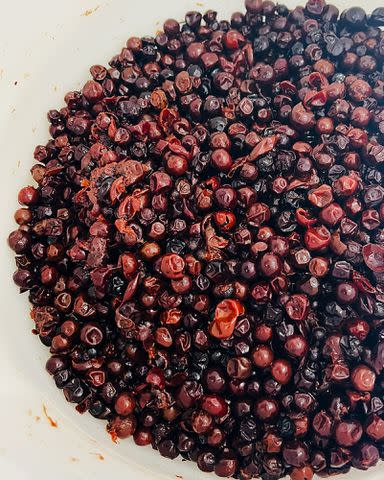Guavaberry Liqueur Deserves a Spot On Your Bar Cart
Whether you're swapping out white rum in a daiquiri or using it in a holiday tart, Guavaberry liqueur imparts a taste of St. Martin tradition.

Getting Images
Centuries ago, a holiday liqueur was crafted in homes across St. Martin/Sint Maarten (SXM) from the fruit of indigenous guavaberry trees, a close cousin to eucalyptus and clove. Families mixed rum, cane sugar, guavaberries (which taste nothing like guava), and other secret ingredients to create the island’s signature drink served at Christmastime.
At weddings around the island year-round, bits of cake and a sip of guavaberry liqueur are given to guests in thanks. Restaurants and bars on the Dutch and French sides serve drinks like Guavaberry Coladas, honoring their national spirit, year-round. For an intimate tasting experience, visitors head to La Part des Anges in Grand Case, a rum bar adjoining Le Pressoir that offers a cozy setting in which to sample a variety of Caribbean rums, including, of course, locally-produced Guavaberry.
My first sip of guavaberry was in 2015. Then Hurricane Irma devastated the island in 2017, making a return trip impossible. In 2020 the pandemic shut down travel and I was diagnosed with breast cancer. When I finished treatments in March 2022, a trip to the “Friendly Isle” topped my list. I wanted to see the island’s recovery while letting my body heal from daily treatments. I wanted a sip of that beverage that reminded me of happy times.

Carrie Honaker
Visitors can enjoy the spirit (traditionally mixed in glass demijohns, a teardrop-shaped bottle) at the Guavaberry Colombier Tradition, while learning about its history, and sampling specialty flavors crafted by the hands of the Maccow family, who founded the distillery and maintain the generational recipe.
On a recent trip, Louis Maccow ushered me into a room filled with glass containers holding varying shades of purple liquid brimming with blueberry-looking fruit. Maccow grew up watching his parents make Guavaberry liqueur, and now he and his wife, Luz Maria, (with the occasional help of nieces and nephews), continue the family tradition.
He pulled one of the jars down from a shelf to show me today’s date on the seal, explaining that guavaberry mash spends one year fermenting before it’s ready for bottling. The bottles are hand-painted and filled with the spirit as well as a handful of the fruit before sealing and covering with a bit of colorful fabric. He would not give up the recipe; he winked as he told me it passes from one generation to the next, within the family.
As we filtered the jar in preparation to bottle, he described the fleeting span of the fruiting season. To keep the production on track, he freezes batches of guavaberries at harvest, ensuring he can produce the liqueur, as well as his signature jam, year-round to supply his storefront, a Creole hut in Marigot, and his tasting room in Colombier.
In the tasting room, I tried all the variations. The traditional liqueur crafted with the midnight purple fruit tasted like the holidays with notes of pine, berry, and a spicy backheat. The three-year cask-aged version has a much more concentrated texture that feels hot on the taste buds. The lighter liqueur, made from yellow-orange guavaberries, presented a much sweeter nose layered with an anise flavor.
As we headed to the grove of trees, Maccow explained most guavaberry grow in Colombier, though you can find a few sprouting around the island. Different families have farms, and you need a connection to the farmer to acquire some of the harvest for personal use. From seedling to reaping can take ten years.
Like Maccow, Paul Peterson, three-time winner of Taste of the Caribbean, and dubbed a Top 5 Best Bartender in the World at the Angostura Global Cocktail Challenge held annually in Trinidad, grew up watching his family make the spirit.
“Guavaberry embodies the rich island traditions steeped through many generations,” he explained.“From growing the berries and harvesting, to the very personal way each maker enhances the infusion with their own choice of spices — Guavaberry is a true labor of love. Every time I crack open a bottle, I am transported back to childhood, and my grandmother's batches tucked safely away under the kitchen sink in preparation for the next year,” he said.
Whether sipping it neat with friends around the holidays, replacing the typical white rum found in coladas and daiquiris, or using it in a holiday tart, Guavaberry liqueur imparts a taste of SXM culture and heritage.

Carrie Honaker
“I’m working on a guavaberry infusion in high-proof spirit to make bitters for a twist on an old-fashioned,” Peterson said. His wife, Culinary Institute of America-trained chef Kristin Joseph, uses the guavaberry for gastriques, barbecue sauces, and even sorbets topped with flambé fruit for guests at the Flavor Academy, their Sint Maarten cooking school and private dinner club.
However, it’s when the weather chills slightly, holiday lights brighten the streets and markets, and harvest season sets in that guavaberry shines. The island tradition is to have it on hand at Christmas when carolers circle neighborhoods, stopping at houses to sing the “Guavaberry Song'' in hopes the homeowner will share a sip of the national spirit.
For many, this spirit links the past and future of Sint Maarten/St. Martin, as well as providing a symbolic bridge between the two territories separating the island.

